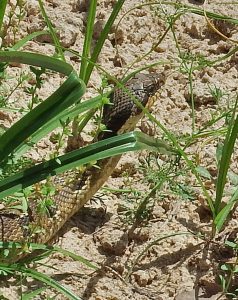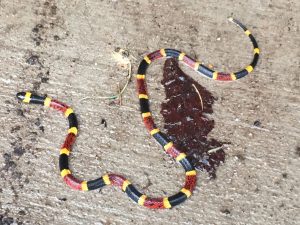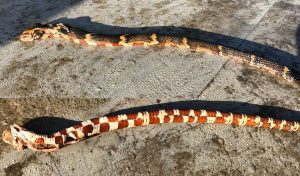Snaaaaaakes!
According to a 1998 Gallup survey, more Americans were afraid of snakes than of anything else. In 2001, again, snakes led the way. In 2014, surprise, it was SNAKES! You can safely say that at almost any point in human history (I mean, it was a serpent in the Garden of Eden) humanity’s chief fear has been snakes.
Not everyone is afraid of snakes, but the biology pushing us towards this fear is powerful. Three year olds (American three year olds) found it much easier to pick out an image of a snake from a grouping of similarly colored animals, plants and shapes than it was to pick out an image of any of those things in a grouping of snakes. The toddlers had no experience of snakes, humans are simply hardwired to notice them, even within a scattered visual field.
Anthropologist Lynne Isbel contends that snakes were essential to the evolution of primate brains. She has demonstrated that Macaque monkeys who had never been exposed to snakes, had a particular set of neurons (located in the center of the brain associated with fear) whose sole job was to identify snakes and allow us to take evasive measures before the conscious brain even has the chance to engage. This set of neurons is present in all primates. We may owe our excellent binocular vision and color perception to our ancestors’ need to avoid snakes.
When mammals were evolving, snakes represented one of their greatest mortal dangers. Creatures that evolved to detect snakes quickly had greater opportunities to pass on their genes. This is also true for spiders. Snakes and spiders are the two creatures our brains are wired to avoid.
Of course, the world is not the same now as it was during early primate evolution. In 2016, 37,461 Americans died in motor vehicle accidents. Guns killed 35,000 of us. Snakes killed five. That is a minuscule number in a country of 3.5 billion. Even our beloved dogs kill 20 to 30 Americans each year. Spiders, by the way, get about seven of us annually.
Our enormous fear of snakes cannot be tied to the actual danger that they pose to us now, but evolution is powerful and also slow. It will take time for our brains to catch up to what imperils us now. And by then, who knows what will be wiping us off whatever planet we are on.
We cannot easily change our brains, but we can use them to override impulses that have no basis in reality. We learn to sleep peacefully despite the dark regions below the bed. Eventually, as we age, we can even walk into basements without trembling. If we put our minds to it, we can encounter snakes without terror. And, if we cannot manage that, we can at least not kill them on first sight.
This is a dead Broad-Banded Water Snake. I found him across from the Police Memorial. He is dead probably because someone saw a snake in or near the water and decided it was a Cottonmouth. It wasn’t. It was a lovely and harmless snake. But even if it were a Cottonmouth, you are perfectly free to look away and walk away. The last known Cottonmouth bite death in the US was in 2015. So, in the past three years the score stands, Cottonmouths 1, Humanity, too many to even estimate.
Killing a snake serves no purpose except to scratch an outmoded evolutionary itch. So stop it. And brace yourself for terrifying and wonderful news: Buffalo Bayou Park is full of snakes. This is terrifying because of all the evolutionary pressure pushing us to fear snakes with a passion. It is wonderful news because Buffalo Bayou Park is a healthy ecosystem that can support a variety of snakes.
So, without further ado, allow me to introduce you to a few of the wonderful (living) snakes I have met in the park.
First, a Diamond Backed Water Snake, further proof that all swimming snakes are not Cottonmouths! I encountered this fellow under the bat bridge.
Here is the same snake in a still shot. Notice her forked tongue extended (you can click on any photo to see it in a larger size). Snakes flick their tongues in and out to make use of their Jacobson’s organ, an olfactory gland that can detect pheramones. The tongue picks up the pheramones and delivers them to the Jacobson’s organ on the roof of the snake’s mouth. It is believed that the fork in the tongue allows the snake to track the origin of the pheramones, in much the same way our two eyes and two ears help us locate things we encounter.

Diamond Backed Water Snake, notice the forked tongue. The snake uses that to help find the small fish and other water-borne creatures that the snake eats.

Hog Nose Snake. You can just make out the slight upturn at the end of his nose that gives this snake his name.
This Hog Nose Snake slithered right up to me as I was photographing the Diamond Backed Water Snake. It was a banner day for snakes in the park! This isn’t the best photo, but in my defense, he wasn’t the most cooperative snake on the planet, either.

I ran into (quite literally, I was out for a run) this Coral Snake under the bat bridge. And I did have to repeat the rhyme “red and yellow will kill a fellow, red and black is a friend of Jack” to make sure this was really a Coral Snake. And still, this cooperative lady (or gent) stayed with me long enough to permit this photo.
This Coral Snake was under the bat bridge. She wasn’t very large (that leaf in the background is about three inches long, but she was quite cooperative in posing for photographs.
While Coral Snakes possess the most potent venom of all North American snakes, they are also among the least dangerous. They have rearward facing fangs in the back of their mouths. Those fangs are well positioned to kill the Coral Snake’s prey, they are very ineffective at biting humans. Most Coral Snake bites occur when someone is gardening without gloves and sticks their hand into leaf litter. The last U.S. death from a Coral Snake bite was in 1967.
I hope no one has fled in terror from these photos, and I even more strongly hope that knowing about snakes in our Park doesn’t make you less likely to visit. But perhaps it should make you a bit less likely to walk barefoot off the paths.


